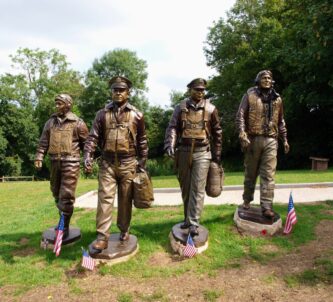This impressive howitzer was designed for the US Army in the inter-war years to fill a requirement for a modern long-range field-artillery piece. Its development was a little sluggish. The first model was produced in 1920, but it wasn’t until 1940 that the bugs were ironed out and it was put into service. It first saw action in North Africa in December 1942.
It was nicknamed ‘Long Tom’ by the troops, which was not an unusual nickname in the history of artillery, but you can see why the 7.05m long barrel might inspire the name.
The gun could fire a 45 kg shell to a range of 23.7 kilometres. Unlike traditional howitzers it was designed, with a maximum elevation of 65°, to hurl shells on a low flat trajectory, leaving the barrel at 853 m/s – a little faster than the much feared German 88mm. Its 14/15-man crew, if well trained, could fire over 45 rounds per hour. The ammunition was ‘separate-loading’, IE shell first (high explosive, smoke, illumination shells, and even armour-piercing), then a number of powder charges depending on the desired range.
It was a large and heavy gun for a towed artillery piece, so it needed a large crew and a heavyweight tractor to pull it. After WW2 the gun was mounted on its own tracked M4 Sherman chassis and became the M40 Self-Propelled Gun (SPG), which was used, along with the towed version, in the Korean war. In total 1,880 ‘Long Toms’ were produced and they saw service with many national armies, including the UK, which is why they are not rare to find in military museums. There are sixteen in the USA and at least four in the UK. There used to be one in the Land Warfare building at IWM Duxford, but they are reducing the collection so I’m not sure where that one is now. They do still have an M40 SPG version, which the British Army called a ‘Cardinal’.
The featured ‘Long Tom’ can be seen in the car park at the Omaha Beach Memorial Museum in Normandy.
I’m particularly fond of the 155mm ‘Long Tom’. As a child I had the Britains diecast model gun. It was fabulous. Breech loading with sprung-loaded brass shell casings that you capped with a little plastic shell (until you lost them all and had to make do with self-moulded plasticine cannonballs), great fun!







